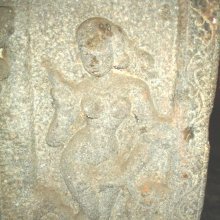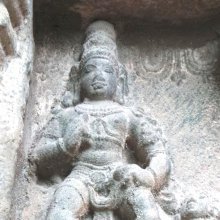Katisama, Kaṭisama: 3 definitions
Introduction:
Katisama means something in Hinduism, Sanskrit. If you want to know the exact meaning, history, etymology or English translation of this term then check out the descriptions on this page. Add your comment or reference to a book if you want to contribute to this summary article.
Images (photo gallery)
In Hinduism
Natyashastra (theatrics and dramaturgy)
Source: Wisdom Library: Nāṭya-śāstraKaṭisama (कटिसम).—One of the 108 karaṇas (minor dance movement) mentioned in the Nāṭyaśāstra chapter 4. The instructions for this kaṭisama-karaṇa is as follows, “feet to be separated, after the Svastika Karaṇa, of the two hands one to be placed at the navel and the other at the hip, and the sides in the Udvāhita pose.”.
A karaṇa represents a minor dance movements and combines sthāna (standing position), cārī (foot and leg movement) and nṛttahasta (hands in dancing position).
Source: Shodhganga: Elements of Art and Architecture in the Trtiyakhanda of the Visnudharmottarapurana (natya)Kaṭisama (कटिसम) refers to one of the 108 kinds of Karaṇa (“coordination of precise movements of legs and hands”), according to the Viṣṇudharmottarapurāṇa, an ancient Sanskrit text which (being encyclopedic in nature) deals with a variety of cultural topics such as arts, architecture, music, grammar and astronomy.—According to the Viṣṇudharmottarapurāṇa, karaṇas are the coordination of precise movements of legs and hands performed in a particular posture. The Nāṭyaśāstra also gives its view point in the same spirit. In the Viṣṇudharmottarapurāṇa, one hundred and eight kinds of karaṇas are accepted, e.g., Kaṭisama.

Natyashastra (नाट्यशास्त्र, nāṭyaśāstra) refers to both the ancient Indian tradition (shastra) of performing arts, (natya—theatrics, drama, dance, music), as well as the name of a Sanskrit work dealing with these subjects. It also teaches the rules for composing Dramatic plays (nataka), construction and performance of Theater, and Poetic works (kavya).
Shilpashastra (iconography)
Source: Archaeological Survey of India: Śaiva monuments at Paṭṭadakal (śilpa)Kaṭisama (कटिसम).—In this mode, according to the text of the Nāṭyaśāstra, the legs are required to be in the pose known as the svastikāpasrita (svastikāpasṛta), while one of the hands should be near the navel, and the other on the hip; and the pelvis should be in the udvāhita pose.
The mode of standing in the kaṭisama dance is technically known as the vaiṣṇavasthāna, which Abhinavaguptācārya describes as follows: In this vaiṣṇavasthāna one leg should be resting firmly on the ground and the other bent and placed across the first at a distance of two and half aṅgula. This sort of posture is prescribed for men when they are conversing with others or throwing the discus. (T. A. G. Rao)

Shilpashastra (शिल्पशास्त्र, śilpaśāstra) represents the ancient Indian science (shastra) of creative arts (shilpa) such as sculpture, iconography and painting. Closely related to Vastushastra (architecture), they often share the same literature.
See also (Relevant definitions)
Starts with: Katisamakarana.
Relevant text
Search found 6 books and stories containing Katisama, Kaṭisama; (plurals include: Katisamas, Kaṭisamas). You can also click to the full overview containing English textual excerpts. Below are direct links for the most relevant articles:
Vishnudharmottara Purana (Art and Architecture) (by Bhagyashree Sarma)
2.5. Karaṇa (movements of legs and hands) < [Chapter 3 - Drama and Dance]
Gati in Theory and Practice (by Dr. Sujatha Mohan)
Gati in classical dance form of Oḍissi < [Chapter 4 - Practice of Gati]
Pallava period (Social and Cultural History) (by S. Krishnamurthy)
Scheme of Pallava Sculptures < [Chapter 2 - Origin of Sculptural Art—Its Development and Scheme]
Natyashastra (English) (by Bharata-muni)
The Religion and Philosophy of Tevaram (Thevaram) (by M. A. Dorai Rangaswamy)
Chapter 4.3 - (a) Nataraja (the dance of Shiva) < [Volume 2 - Nampi Arurar and Mythology]
Dance Traditions of South India < [May-June 1935]

